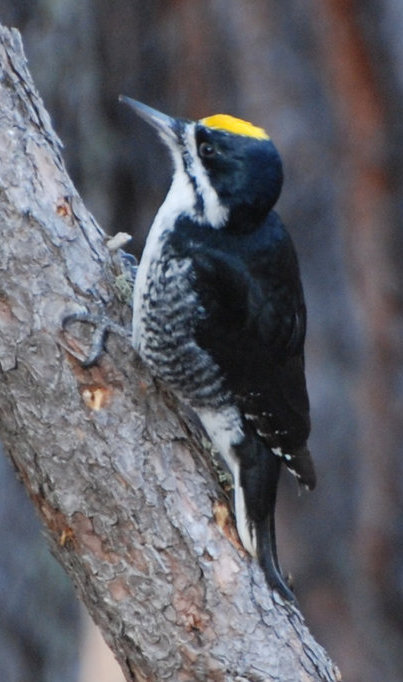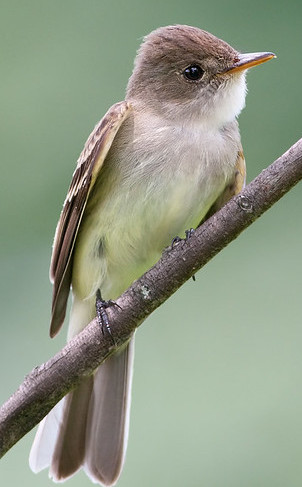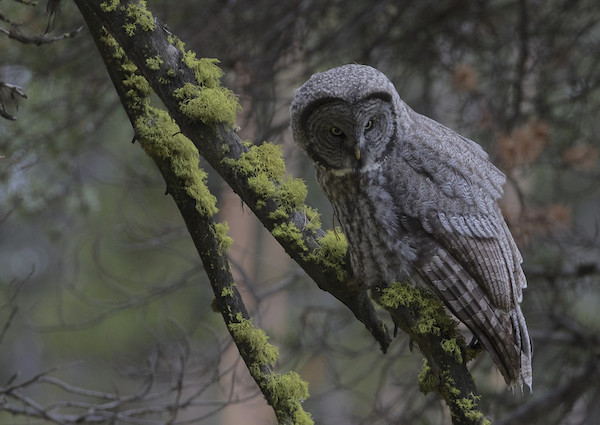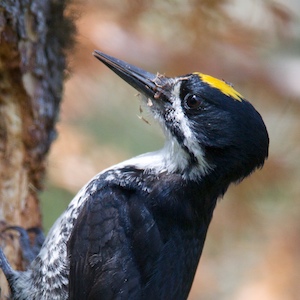Most scientists are familiar with this response to their work: "Cool research, but what difference will it make?" At IBP, we conduct research that tackles important problems in conservation, but does our science make a difference? Do the lessons we learn get put into practice? The answer is yes, and one of the important tools for translating science into action is a "conservation strategy."
A conservation strategy is essentially a guidebook for land and wildlife managers, private landowners and other stakeholders that lays out best practices for conserving a particular species in a particular region. It summarizes the science on the ecology, population status, and conservation needs of a species of conservation concern, and recommends specific conservation actions to halt and reverse population declines.

Black-backed Woodpeckers in the Sierra Nevada prefer recently burned forest habitat. Photo courtesy of the USFWS.
In recent years IBP has been asked to write three conservation strategies for Sierra Nevada bird species. The U.S. Forest Service asked us to write a Black-backed Woodpecker conservation strategy based on our many years of research and monitoring of this post-fire specialist. The California Department of Fish and Wildlife (CDFW) commissioned IBP to write a conservation strategy for the Great Gray Owl (a California Endangered Species) based on our work in the field with the species, as well IBP biologist Helen Loffland's expertise in Sierra meadow ecology. Helen's extensive experience with another California Endangered Species – Willow Flycatcher – also prompted CDFW to ask us to write a statewide conservation strategy for that declining species.
When we write a conservation strategy, we summarize all of the relevant research on a species- not just our own. We also seek out expert opinions. When preparing the Black-backed Woodpecker strategy, IBP held a symposium with presentations and discussion by experts as well as the interested public. For the Great Gray Owl and Willow Flycatcher strategies, we conducted one-on-one interviews with many species experts to get their input. After synthesizing all of the best research and knowledge, we develop specific, actionable recommendations that are based on evidence. Effective conservation is evidence-based and conservation strategy documents help put that evidence in the hands of land managers.
Our conservations strategies are not regulatory documents–they contain recommendations, not laws. But these documents can generate changes in land management practice to benefit species of conservation concern. For instance, the Black-backed Woodpecker Conservation strategy recommended that forest managers evaluate their post-fire logging plans using the Black-backed Woodpecker Abundance model which is based on research by Dr. Morgan Tingley of UCLA and IBP scientists. The model helps managers predict which burned areas will be most attractive to the woodpeckers, so they can refrain from harvesting trees in areas that are most important to the birds. The U.S. Forest Service has been using the model to assess and reduce detrimental effects of post-fire logging on Black-backed Woodpeckers since 2016.

The Willow Flycatcher is a California Endangered Species. Photo by Kelly Colgan Azar.
Likewise, two of the recommendations from our Great Gray Owl conservation strategy are reflected in the U.S. Forest Service's latest Land and Resource Management Plans for National Forests in the Sierra Nevada Region. These majestic owls nest in dense forest adjacent to montane meadows where they hunt for small mammals, and the transition between forest and meadow habitat is important to them. The conservation strategy recommends that when restoring meadow habitat, land managers remove encroaching trees and create both abrupt transition between forest and meadow and soft edges with a few scattered trees that soften the transition. The owls prefer low perches (1-6 meters off the ground) on the meadow's edge for hunting. The strategy recommended that land managers preserve good perches and even install perches where they are in limited supply.
We are still finalizing our Willow Flycatcher conservation strategy, but we are optimistic that its recommendations will have a positive impact on this California Endangered Species which has seen drastic declines in the past decades. Willow Flycatchers nest and hunt insects in wet montane meadows and meadow desiccation is thought to be a major contributor to their decline in the Sierra Nevada. Helping land managers tailor meadow restoration efforts to benefit Willow Flycatchers and other meadow birds is an important component of the strategy, and a major focus of IBP’s work in the Sierra Nevada.
At IBP, we don't conduct science in a vacuum. We study critical conservation problems and work to find practical solutions that can benefit birds and other wildlife. We are always in dialogue with land managers and other stakeholders to ensure that our recommendations are rooted in on-the-ground reality. Conservation strategies are a great way to translate our science into land management decisions, where it can make a real difference for birds.






